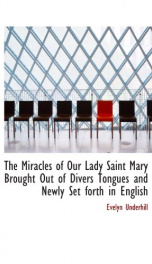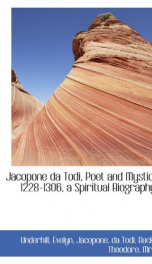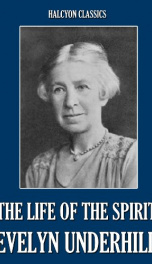Underhill Evelyn

Evelyn Underhill (December 6, 1875 – June 15, 1941) was an English Anglo-Catholic writer and pacifist known for her numerous works on religion and spiritual practice, in particular Christian mysticism. In the English-speaking world, she was one of the most widely read writers on such matters in the first half of the twentieth century. No other book of its type—until the appearance in 1946 of Aldous Huxley's The Perennial Philosophy—met with success to match that of her best-known work, Mysticism, published in 1911.[1] Underhill was born in Wolverhampton. She was a poet and novelist, as well as being a pacifist and mystic. An only child, her early mystical insights she described as "abrupt experiences of the peaceful, undifferentiated plane of reality—like the "still desert" of the mystic—in which there was no multiplicity nor need of explanation."[2] The meaning of these experiences became a lifelong quest and source of private angst, provoking her to research and write. Both her father and her husband were writers (on the law), London barristers and yachtsmen. She and her husband, Hubert Stuart Moore, grew up together and were married on July 3, 1907. The couple had no children. She traveled regularly to the continent, primarily Switzerland, France and Italy where she pursued her interests in art and Catholicism, visiting numerous churches and monasteries. Neither her husband (a Protestant) nor her parents shared her interest in spiritual matters. Underhill was called simply "Mrs. Moore" by many of her friends, but was not without her detractors. She was a prolific author and published over thirty books either under her maiden name Underhill or under the pseudonym John Cordelier, as was the case for the 1912 book The Spiral Way. Initially an agnostic, she gradually began to acquire an interest in Neoplatonism and from there became increasingly drawn to Catholicism against the objections of her husband, becoming eventually a prominent Anglo-Catholic. Her spiritual mentor from 1921–24 was Baron Friedrich von Hügel, who was appreciative of her writing, yet concerned with her focus on mysticism and encouraged her to adopt a much more Christocentric view as opposed to the theistic/intellectual one she had previously held. She described him as "the most wonderful personality. ..so saintly, truthful, sane and tolerant," (Cropper, p. 44) and she was influenced toward more charitable, down to earth activities. After his death in 1925, her writings became more focused on the Holy Spirit and she became prominent in the Anglican Church as a lay leader of spiritual retreats, a spiritual director for hundreds of individuals, guest speaker, and radio lecturer/proponent of the power of contemplative prayer. Underhill came of age in the Edwardian era, at the turn of the century, and like most of her contemporaries had a decided romantic bent. The enormous excitement in those days, was mysteriously compounded of the psychic, the psychological, the occult, the mystical, the medieval, the advance of science, the apotheosis of Art, the re-discovery of the feminine and an unashamedly sensuous and the most ethereally 'spiritual'. Anglicanism seemed to her out-of-key with this, her world. She sought centre of life as she and many of her generation conceived it, not in the state religion, but in experience and the heart. This age of 'the soul', was one of those periods when a sudden easing of social taboos brings on a great sense of personal emancipation and desire for an El Dorado despised by an older, more morose and insensitive generation.[1] As an only child she was devoted to her parents, and later to her husband. She was fully engaged in the life of a barrister's daughter and wife - the entertainment and charitable work that entailed - and a daily regimen that included her own writing, research, worship, prayer and meditation. It was a fundamental axiom of Evelyn Underhill, that all of life was sacred - as that was what "incarnation" was about. Underhill was educated at home, except for three years at a private school in Folkestone, and subsequently read history and botany at King's College London. She was conferred with an honorary Doctorate of Divinity from Aberdeen University and made a fellow of King's College. She was the first woman to lecture to the clergy in the Church of England as well as the first woman to officially conduct spiritual retreats for the Church. She was also the first woman to establish ecumenical links between churches and one of the first woman theologians to lecture in English colleges and universities, as she did frequently. Underhill was an award-winning bookbinder, studying with the most renowned masters of the time. She was schooled in the classics, well read in Western spirituality, well informed (in addition to theology) in the philosophy, psychology, and physics of her day, and acquired the prestigious post as editor of The Spectator. Before undertaking many of her better known expository works on mysticism, she first published a small book of satirical poems on legal dilemmas, The Bar-Lamb's Ballad Book, which received a favorable welcome. Underhill then wrote three highly unconventional though profoundly spiritual novels. Like Charles Williams and later, Susan Howatch, Underhill uses her narratives to explore the sacramental intersection of the physical with the spiritual. She then uses that sacramental framework very effectively to illustrate the unfolding of a human drama. Her novels are entitled The Grey World (1904), The Lost Word (1907), and The Column of Dust (1909). In her first novel, The Grey World, described by one reviewer as an extremely interesting psychological study, the hero's mystical journey begins with death, and then moves through reincarnation, beyond the grey world, and into the choice of a simple life devoted to beauty, reflecting Underhill's own serious perspective as a young woman. "It seems so much easier in these days to live morally than to live beautifully. Lots of us manage to exist for years without ever sinning against society, but we sin against loveliness every hour of the day."[3] The Lost Word and The Column of Dust are also concerned with the problem of living in two worlds and reflect the writer's own spiritual challenges. In the 1909 novel, her heroine encounters a rift in the solid stuff of her universe: She had seen, abruptly, the insecurity of those defences which protect our illusions and ward off the horrors of truth. She had found a little hole in the wall of appearances; and peeping through, had caught a glimpse of that seething pot of spiritual forces whence, now and then, a bubble rises to the surface of things. ..[4] Underhill's novels suggest that perhaps for the mystic, two worlds may be better than one. For her, mystical experience seems inseparable from some kind of enhancement of consciousness or expansion of perceptual and aesthetic horizons—to see things as they are, in their meanness and insignificance when viewed in opposition to the divine reality, but in their luminosity and grandeur when seen bathed in divine radiance. But at this stage the mystic's mind is subject to fear and insecurity, its powers undeveloped. The first novel takes us only to this point. Further stages demand suffering, because mysticism is more than merely vision or cultivating a latent potentiality of the soul in cosy isolation. According to Underhill's view, the subsequent pain and tension, and final loss of the private painful ego-centered life for the sake of regaining one's true self, has little to do with the first beatific vision. Her two later novels are built on the ideal of total self-surrender even to the apparent sacrifice of the vision itself, as necessary for the fullest possible integration of human life. This was for her the equivalent of working out within, the metaphorical intent of the life story of Jesus. One is reunited with the original vision—no longer as mere spectator but as part of it. This dimension of self-loss and resurrection is worked out in The Lost Word, but there is some doubt as to its general inevitability. In The Column of Dust, the heroine's physical death reinforces dramatically the mystical death to which she has already surrendered to. Two lives are better than one but only on the condition that a process of painful re-integration intervenes to re-establish unity between Self and Reality.[1] All her characters derive their interest from the theological meaning and value which they represent and it is her ingenious handling of so much difficult symbolic material that makes her work psychologically interesting as a forerunner of such 20th century writers as Susan Howatch, whose successful novels also embody the psychological value of religious metaphor and the traditions of Christian mysticism. Her first novel received critical acclaim, but her last was generally derided. However her novels give remarkable insight into what we may assume was her decision to avoid what St. Augustine described as the temptation of fuga in solitudinem ("the flight into solitude"), but instead acquiescing to a loving, positive acceptance of this world. Not looking back, by this time she was already working on her magnum opus. Underhill's greatest book, Mysticism: A Study of the Nature and Development of Man's Spiritual Consciousness, was published in 1911, and is distinguished by the very qualities which make it inappropriate as a straightforward textbook. The spirit of the book is romantic, engaged, and theoretical rather than historical or scientific. Underhill has little use for theoretical explanations and the traditional religious experience, formal classifications or analysis. She dismisses William James' pioneering study, The Varieties of Religious Experience (1902), and his "four marks of the mystic state" (ineffability, noetic quality, transcience, and passivity). James had admitted that his own constitution shut him off almost entirely from the enjoyment of mystical states thus his treatment was purely objective. Underhill substituted (1) mysticism is practical, not theoretical, (2) mysticism is an entirely spiritual activity, (3) The business and method of mysticism is love. (4) mysticism entails a definite psychological experience. Her insistence on the psychological approach was that it was the glamorous science of the pre-war period, offering the potential key to the secrets of human advances in intelligence, creativity, and genius, and already psychological findings were being applied in theology (i.e.,William Sanday's Christologies Ancient and Modern).[1]
do you like this author?
What readers are saying
What do you think? Write your own comment on this book!
write a commentWhat readers are saying
What do you think? Write your own comment on this author!
write a commentBook list

Practical Mysticism
A Little Book for Normal People
Series:
Unknown
Year:
Unknown
Raiting:
5/5
Show more
add to favoritesadd In favorites

theophanies a book of verses
Series:
Unknown
Year:
Unknown
Raiting:
3.5/5
1916. Underhill was a noted poet and these mystical poems reflect her inner illumination and joy of living.
Show more
add to favoritesadd In favorites

the spiral way being meditations upon the fifteen mysteries of the souls ascen
Series:
Unknown
Year:
Unknown
Raiting:
4/5
Show more
add to favoritesadd In favorites
Book list

Practical Mysticism
A Little Book for Normal People
Series:
Unknown
Year:
Unknown
Raiting:
5/5
Show more
add to favoritesadd In favorites

theophanies a book of verses
Series:
Unknown
Year:
Unknown
Raiting:
3.5/5
1916. Underhill was a noted poet and these mystical poems reflect her inner illumination and joy of living.
Show more
add to favoritesadd In favorites

the spiral way being meditations upon the fifteen mysteries of the souls ascen
Series:
Unknown
Year:
Unknown
Raiting:
4/5
Show more
add to favoritesadd In favorites

the miracles of our lady saint mary brought out of divers tongues and newly set
Series:
Unknown
Year:
Unknown
Raiting:
3/5
Show more
add to favoritesadd In favorites

the grey world
Series:
Unknown
Year:
Unknown
Raiting:
3.5/5
First novel by Evelyn Underhill, an English Anglo-Catholic writer and pacifist known for her numerous works on religion and spiritual practice, in particular Christian mysticism, the author of more than 39 books and 350 essays. This interesting psychological study tells an unusual story of the boy's mystical journey that begins after death. Through reincarnation the protagonist travels beyond the grey world, the world of the dead.
Show more
add to favoritesadd In favorites

jacopone da todi poet and mystic 1228 1306 a spiritual biography
Series:
Unknown
Year:
Unknown
Raiting:
4/5
Show more
add to favoritesadd In favorites

The Life of the Spirit and the Life of To-day
Series:
Unknown
Year:
Unknown
Raiting:
3/5
This Halcyon Classics eBook contains two works by noted Anglo-Catholic writer Evelyn Underhill. Includes an active table of contents for easy navigation.Contents:Practical MysticismThe Life of the Spirit and the Life of To-Day
Show more
add to favoritesadd In favorites
What readers are saying
What do you think? Write your own comment on this author!
write a commentif you like Underhill Evelyn try:
readers also enjoyed
What readers are saying
What do you think? Write your own comment on this author!
write a commentGenre
if you like Underhill Evelyn try:
readers also enjoyed
Do you want to read a book that interests you? It’s EASY!
Create an account and send a request for reading to other users on the Webpage of the book!


